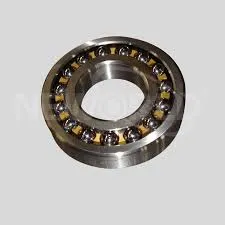
Nov . 06, 2024 11:16 Back to list
small tapered roller bearing
Understanding Small Tapered Roller Bearings
Small tapered roller bearings are essential components in various mechanical systems, offering effective solutions for managing both radial and axial loads. These bearings are designed with tapered inner and outer raceways, enabling them to accommodate a combination of forces while ensuring smooth, efficient motion. This article explores the structure, functionality, advantages, and applications of small tapered roller bearings.
Structure and Design
The defining feature of small tapered roller bearings is their conical shape. The rollers are arranged so that their axes converge at a single point along the bearing axis. This design allows them to handle not only radial loads but also significant axial loads in one direction. Typically, these bearings consist of four main parts the outer ring, the inner ring, the tapered rollers, and the cage. The cage, or retainer, holds the rollers in place and allows them to roll freely without clumping together.
The materials used in manufacturing small tapered roller bearings are often high-quality steel or ceramic, providing durability and resistance to wear. Advanced technologies in heat treatment also enhance the performance and lifespan of these bearings, enabling them to operate efficiently under various conditions.
Functionality
The primary function of small tapered roller bearings is to reduce friction between moving parts in machinery. By providing a smooth surface for rotation, these bearings minimize energy losses, enhance operational efficiency, and prolong the life of mechanical components. The tapered design helps distribute loads evenly, reducing stress concentrations that could lead to premature failure.
When properly lubricated, which is crucial for their performance, these bearings can operate at high speeds and in demanding environments. Lubrication reduces friction, dissipates heat, and protects against contaminants, further improving reliability.
Advantages
small tapered roller bearing

Small tapered roller bearings offer numerous advantages, making them a popular choice across various industries. Their ability to handle both radial and axial loads reduces the number of components required in machinery, simplifying designs and reducing weight. This dual capability is particularly advantageous in applications where space is at a premium.
Another benefit is their high load-carrying capacity. Compared to other bearing types like ball bearings, tapered roller bearings can handle greater forces, which is crucial in applications such as automotive and aerospace, where safety and performance are paramount.
Additionally, these bearings exhibit excellent wear resistance due to their robust material composition, leading to longer service intervals and reduced maintenance costs. Their versatility allows them to be used in diverse applications, from electric motors and gearboxes to wheel hubs and industrial machinery.
Applications
Small tapered roller bearings find applications in various fields, including automotive, aerospace, agriculture, and manufacturing. In the automotive industry, they are commonly used in wheel hubs, where they support loads while facilitating smooth rotation. In aerospace, these bearings play a critical role in the operation of landing gear and other high-stress components.
Moreover, small tapered roller bearings are used in conveyor systems, machine tools, and robotics, showcasing their versatility and reliability across different sectors. Engineers continue to innovate and improve these bearings, striving for designs that offer even greater efficiency and durability.
Conclusion
In summary, small tapered roller bearings are vital components that enhance the functionality and reliability of various mechanical systems. Their unique design, robust construction, and ability to handle complex loading conditions make them indispensable in modern engineering. As technology evolves, the development of new materials and designs will likely further enhance the performance of these bearings, ensuring their continued relevance in a wide array of applications.
Latest news
-
Premium Deep Groove Ball Bearings | High Speed & Reliability
NewsAug.29,2025
-
Durable Scaffolding Clamps - Secure & Reliable Tube Connectors
NewsAug.28,2025
-
Common Failures in Thrust Ball Bearings and Solutions
NewsAug.22,2025
-
How Tapered Roller Bearings Can Take Shock Loads
NewsAug.22,2025
-
Angular Bearings in High-Precision Spindles
NewsAug.22,2025
-
The Impact of Misalignment on Cylindrical Roller Bearing Performance
NewsAug.22,2025
